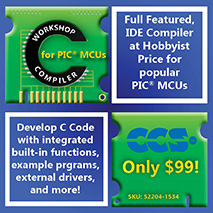
 |
|||||
|
|
|||||

|
Independent
Review
When I wanted to buy
a programmer for PIC micros, the first choice was a PICStart Plus, the official
programmer for PIC micros, from Microchip. I was told by the distributor that
this is the best bet - he said it is more likely to work reliably than the
clone programmers. But, is this correct in reality? Astonishingly, the
clone programmers PICALL and P16PRO, perform better than an official PICStart
Plus. Read on for why I reached
this conclusion ... The PICALL supports the 12X and 16X series PIC micros, and the cheaper P16PRO supports everything except the parallel-programmed PIC16C5x, which is quite rare anyway. They work beautifully.
The designer, Boban Dobaj, has been working on it since 1995 and due to the
amount of orders he gets, is continually updating it. He's had more than a
few hundred thousand hits on his website, and has sold thousands of his programmers
worldwide. Advantages of the PICStart Plus (compared to a PICALL or P16PRO)
Advantages
of the PICALL and P16PRO (compared
to a PICStart Plus)
As I have said, the
clone programmers PICALL and P16PRO,
overall, perform better than an official PICStart
Plus. "I
am a user of the P16PRO programmer. I agree that it is economical and much,
much faster than a PICSTART ! I had to use a PICSTART at a client's site and
I thought something was wrong with it ! I was only loading a small (<200word)
program and it took a long time to do it. I have used my P16PRO to program
a variety of PICs with no problems whatsoever. The software and hardware work
extremely well. As a professional, I don't have time to troubleshoot someone
else's devices. It is important that things work solidly and reliably. This
is definitely the case with the P16PRO. Sometimes the cheap "hobby" tools
cause more trouble than they're worth. This is not the case with the 16PRO
! I recommend it to anyone interested in a PICSTART PLUS alternative. The
only item which needs to be addressed is the support for PIC 17's and 18's.
I use a PICSTART16B1 for my 16c5x programming, and it works fine, but I use
the P16PRO for everything else." Check out the PICALL
and P16PRO programmers, http://www.picallw.com/ The P16PRO design in a commercial situation We've been using the P16PRO programmers as production programmers at our business for 12 months now. They dont verify at anything other than 5V (compared to the ProMate II) but since our devices only run at 5V, its no problem. For non-continuous operation, they work perfectly. For continuous programming operation (more than 5 devices in a row in one session) we found that we had to change the existing regulators for 5V and 8V (74L05 and 74L08) from 100mA to the larger 1000mA versions (7405 and 7408). The rating of 100mA was just not enough. We have had one 7406 buffer
chip blow up, but that was after 400 programming runs over 8 months. It was
5 minutes and a few dollars to fix it. Not bad considering the workload! |
|
We welcome any suggesions or comments! Send them to Shane Tolmie on support@microchipc.com. This site is a completely separate site to www.microchip.com, and is maintained independently of Microchip Ltd., manufacturers of the PIC micro. All code on this site is free for non-commercial use, unless stated otherwise. Commercial use normally free, however, it is prohibited without contacting support@microchipc.com for permission. All content on this site created by Shane Tolmie is copyrighted by Shane Tolmie 1999-2009. Click to advertise on this website - $29.90 for a banner ad which will reach 55,000 user sessions per month. One months free trial! |